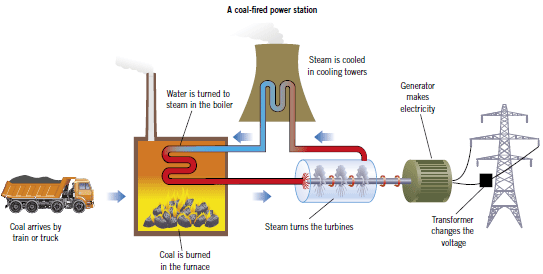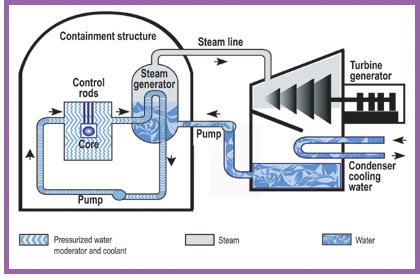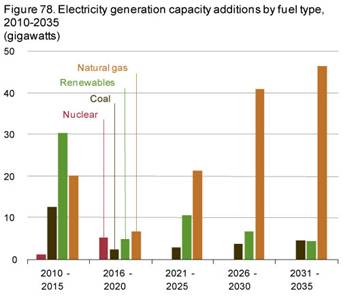In the United States, the primary energy supply consists of six main fuels; 3 of them being coal, natural gas, and nuclear power.
Coal plays a vital role in electrical generation world wide. Coal-fired power plants currently fuel 41% of global electricity. Some countries use coal more than others, but without electricity our modern world would be unlivable. In the United States, coal fuels 45% of our electricity.
So how does a coal-fired power plant work? Before the coal is burned, it is crushed into very fine powder. It is then mixed with hot air and blown into the firebox of the boiler. The coal and air mixture provides a complete combustion. Water is then pumped through pipes inside the boiler and turned into steam by the heat. The pressure of the steam pushing against a series of turbine blades turns the turbine shaft. This shaft is connected to the shaft generator, where magnets spin within wire coils to produce electricity. The water used for this process can be reused over and over again after a cooling process. Below is a diagram of this process.
Although coal is the most common sources of energy generation, it is the largest greenhouse gas emitter. Improvements for coal production are still in processes. New combustion technologies are being developed which allow more electricity to be produced from less coal. This is know as improving the thermal efficiency of the power station. Improvements from coal-fired power stations will play a crucial part in reducing CO2 emissions at a global level. A clear and obvious way of reducing greenhouse gas emissions is by using different fuels for energy supply, such as natural gas.
Natural gas, is another important source of energy generation. Natural gas is a very versatile fossil fuel that we can use for heating our homes, electricity, transportation, and as an industrial feedstock. As of 2012, it made up 30% of the U.S energy mix, and is continuing to be readily available as a domestic resource.
Natural gas is a product of decomposed organic matter, deposited over the past 550 million years. This organic matter mixed with mud, silt, and sand on the sea floor, gradually became buried over time. This matter underwent a thermal breakdown process due to exposure of increasing amounts of heat and pressure, and converted into hydrocarbons. These hydrocarbons exist in a gaseous state (which is essentially natural gas). In it’s pure form natural gas is colorless, odorless and composed primarily of methane. Natural gas is found deep within the earths core in rocks (shale). The way to retrieve natural gas is through a procedure I talked about in my previous blog: Fracking. Fracturing allows us to continue to retrieve natural gas. Natural gas provides us with a source of energy while reducing CO2 emissions, unlike coal. Below is a diagram of the natural gas retrieval process.
Natural gas can be used to generate electricity in various ways. The most basic natural gas-fired electric generation consists of a steam generation unit. With this, fossil fuels are burned in a boiler to heat water and produce steam that then turns a turbine to generate electricity. These basic steam units are more typical of large coal or nuclear generation, but can be used for natural gas as well.
Over the years, there has been an increased reliance on natural gas. Although coal is the cheapest fossil fuel for generating electricity, it is also the dirtiest – releasing the highest levels of pollutants into the air. Natural gas plays an increasingly important role in the clean generation of electricity.Natural gas does not release the same amount of nitrogen oxides or carbon dioxide as coal-fired plants do.
Last but not least is Nuclear power. A nuclear reactor produces and controls the release of energy from splitting atoms such as uranium. Uranium-fuelled nuclear power is a clean and efficient way of boiling water to make steam which drives turbine generators. Apart from it’s reactor, a nuclear power station works like most coal-fired power stations. In the reactor core the uranium fissions (splits), producing heat in a continuous process is called a chain reaction.
This process depends on a moderator such as water or graphite. The moderator slows down the neutrons produced by fission so that they will produce more fissions. The products of the fission stay in the ceramic fuel and undergo radioactive decay, which releases more heat. Steam is formed above the reactor core or in separate pressure vessels, which then drives the turbine to produce electricity. The steam from this process is condensed and the water is reused. Below is a diagram of nuclear power generation.
Unlike fossil fuel plants, nuclear power plants don’t produce smoke (like coal-fired energy production). Nuclear power is considered carbon-free and produces more electricity than other renewable energy sources. Uranium on the other hand is not the easiest resource to get our hands on because it is mined and and transported to power plants. There is also an issue of radioactive waste, which is extremely dangerous. Most plants store nuclear waste in steel-lined concrete basins filled with water, where it remains radioactive for thousands of years.
All three of these energy sources raise concern because they add to the emission of greenhouse gases into our atmosphere. Coal being the worst, and natural gas and nuclear power being better in terms of CO2 emissions. All three of these sources generate electricity through a process where either steam or smoke are generated through turbines within the process. There are several ways in which these sources of energy generation are similar, but the impact they have on CO2 emissions is far more different. But in the end, electricity, heat and transportation would not be possible without these resources.
Sources:
http://www.discovery.com/tv-shows/curiosity/topics/10-pros-cons-nuclear-power.htm
http://www.world-nuclear.org/nuclear-basics/how-does-a-nuclear-reactor-make-electricity-/
http://www.ucsusa.org/clean_energy/our-energy-choices/coal-and-other-fossil-fuels/how-is-natural-gas-formed.html#.VCNvW1zIrL8
http://www.worldcoal.org/coal/uses-of-coal/coal-electricity/
http://www.duke-energy.com/about-energy/generating-electricity/coal-fired-how.asp
Class Text: Beyond Smoke and Mirrors





Hey There. I found your blog using msn. This is an extremely well written article.
I will be sure to bookmark it and return to read more of your useful info.
Thanks for the post. I will certainly return.
Here is my web-site 12kw steam generator
Great post, you have pointed out some fantastic points , I likewise think this s a very wonderful website